
I received a
very positive answer from Wayne with many suggestions for a search (that I already had done).
But he also sent me pictures and some other documents. I made a mention of the second tank
'into Bastogne', the
'Casey Jones' commanded by Lt. Walt Wrolson, on the website where
I write about the liberation of Bastogne on December 26, 1944. And thinking not more about it.
The last message I received from Wayne was the passing of his father, Walt in May 2011.
This restored M4A1(76)W was still in need of a name,...
And the search for a proper name for the M4A1(76)W went on (and got one:
'Fortune Cookie'). All went quiet after that, until Facebook went global. My friend, Ivan Steenkiste, always
in search of information for his subject, the 4th Armored Division during the Battle of the Bulge,
made contacts world wide on his Facebook page 'Chaumont Ardennes Belgium'. And so he came in
contact with Connie Rincker, who's father, Neil French, was a gunner on one of the tanks that
went to Bastogne. When she stumbled on a picture on my website with Walt Wrolson she, and Tony
Costa from the 37th Armor Regiment Alumni, contacted me for more information. The best source
in this was Wayne Wrolson, so, I put everything forward towards Wayne, who responded almost at once.
Wayne had done research by himself, and gave me all his findings, and what a find it was.
One thing was certain, Walt Wrolson was a humble man who spoke not much about his wartime
in Europe, but there is reason enough that this man, and his crew, deserve our gratitude by
putting his story out to the world. So everyone can read that ordinary men, do extra ordinary
things when they are challenged,..
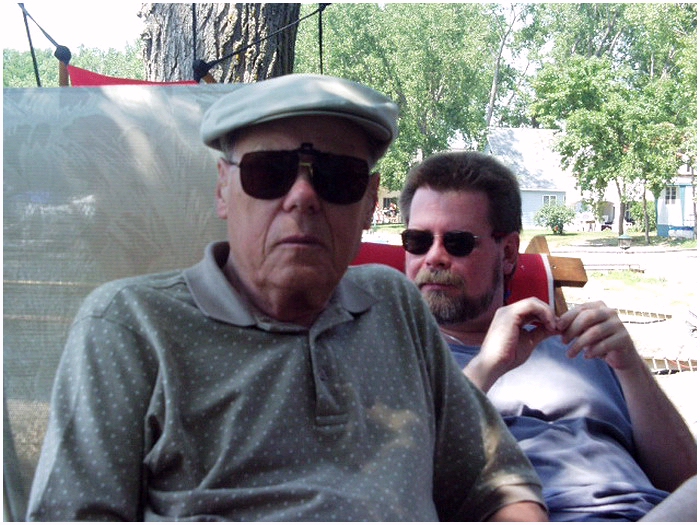
Walter and son Wayne Wrolson
- Walter Woodrow Wrolson -
Wayne Wrolson wrote the story of Walter Woodrow Wrolson. And with kind permission I use large
segments from it, because it is written so well. At some points I will go deeper into the tactical
side, and explain or clarify some things to the ordinary reader.
Walter Woodrow Wrolson was born on September 8, 1919, to Theodore and Annie (Nygaard) Wrolson.
Walter was brought up on a farm near Stady, North Dakota in Smokey Butte Township. Stady consisted
of only a general grocery store so the official address was Appam, North Dakota. Walter was the
youngest of three boys. His older brothers were named Lawny and Julian.
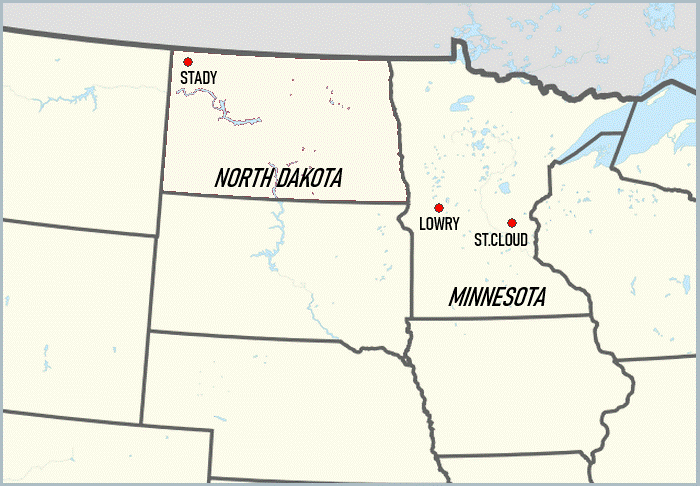
Got ambition,... must travel,... from Stady, ND, to Lowry and St. Cloud, MN
In October 1932, during his 7th grade year, Walter lost his mother Annie to a goiter operation
performed at Minot, North Dakota. Walter's father, Theodore, did not think much of schooling.
So, the year after finishing elementary school he spent working on his fathers farm. Walter
wanted to continue his education. So, Walter convinced his father that he should attend High
School at the local township school, half a mile West of the farm. In the fall of 1935,
Walter attended and completed his first year of High School in the
spring of 1936. From the fall of 1936 to the spring of 1937, in exchange for his room and board,
Walter worked for his uncle Albert Nygaard on his farm in the township West of Smokey Butte,
named Souix Trail Township, while attending and completing his
2nd year of High School at the Souix Trail School.
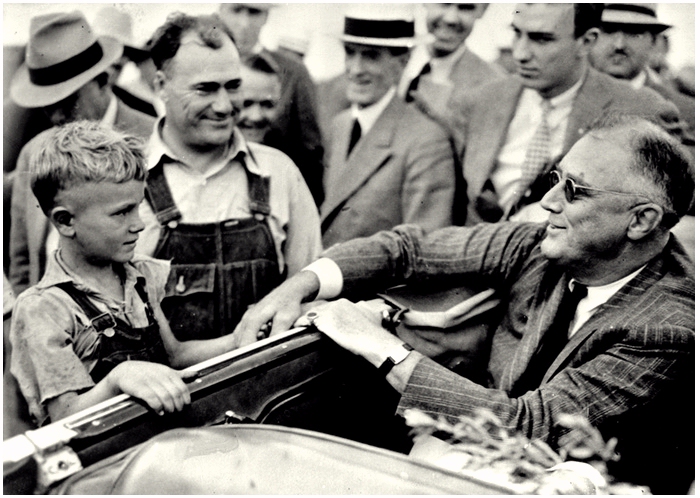
During the Great Depression, President Roosevelt visited North Dakota
in 1934, 1936 and 1937 to bring some hope to the people,...
This were the depression years in the U.S. Everything was dry around Northwestern North Dakota.
Father Theodore was forced to sell all his livestock. He even sold the boys Shetland Pony.
Julian and Lawny were going to go to Minnesota for the summer of 1937 to work on farms in better
off Minnesota around the town of Lowry, where there aunt, from mothers side, Thea and her daughter
Inez lived. Theodore was not keen on it, but had also let Walter go. So, in the summer of 1937
the three boys left for Lowry, Minnesota to work on farms for a dollar a day and their room and board.
During those harsh years, Walter worked, but also went to High School in Glenwood that he finished 1938.
For his Senior year at Hgh School, he moved to Glenwood, took up a job at a café, and helped out at the
Government sponsored NYA (National Youth Administration) as a helper to the physics instructor. The NYA
was part of the New Deal programs in the 1930s, focused on providing work and education for people
between the ages of 16 and 25. The NYA helped between 1935 and 1939 over 4.5 million American youths to find jobs, receive
vocational training, and afford higher standards of education. The NYA was official discontinued in 1943.
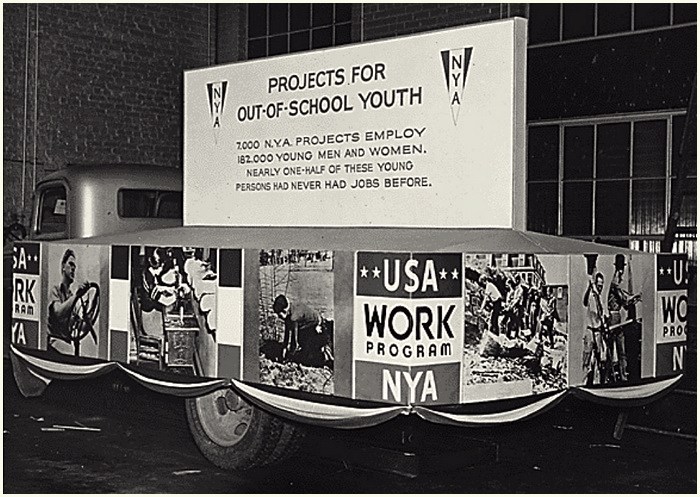
To make the people aware of the National Youth Administration (1937)
Walter
finished his Senior year in Glenwood and graduated with his high school degree in the spring of 1939.
In the summer of 1940 Walter visited St Cloud in the hopes of finding work and a place to stay
while attending St Cloud Teachers College. Again he pounded the streets and found work in a
bakery/restaurant combination called 'Sunlight Bakery/Restaurant'. He could work downtown St
Cloud for his room and board while attending his first year of college. In the spring of 1941 he
finished his first year in college. Walter studied general studies and thought he may end up as a
teacher. Later in the year he went back for a month to North Dakota.
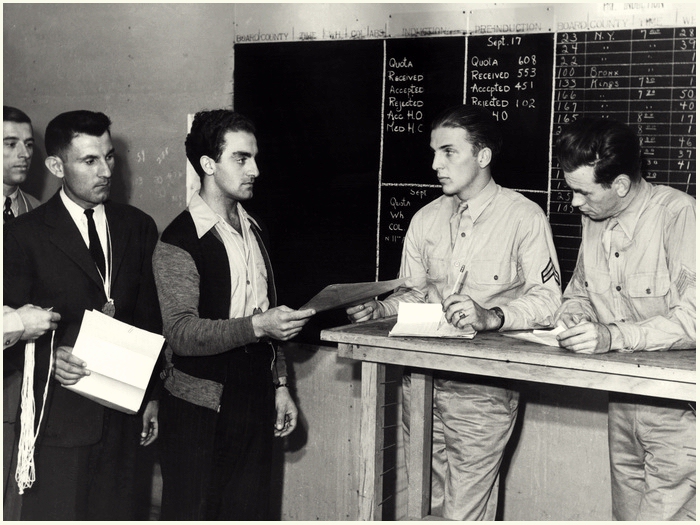
A typical scene at a draft board station during 1941
With war looming on the doorstep of the United States, the draft board wanted Walter to join
the armed forces. The call of the country made Walter decide to volunteer for the Army. He could
get his Army commitment finished by enlisting for one year. He would then be free to return to
Minnesota and continue his college education. In late July 1941, Walter left from Crosby, North
Dakota by bus to Fort Snelling in St Paul for Army induction. His hopes for just one year service
were shattered when Japan attacked Pearl Harbor on December 7, 1941, and the US declared war against the
Axis powers. The next four years, Walter
was commited to follow militairy orders,... all the way in Europe.
For the next chapter,...
Click below on the Sherman in Coutances,
a city liberated by the 4th Armored Division